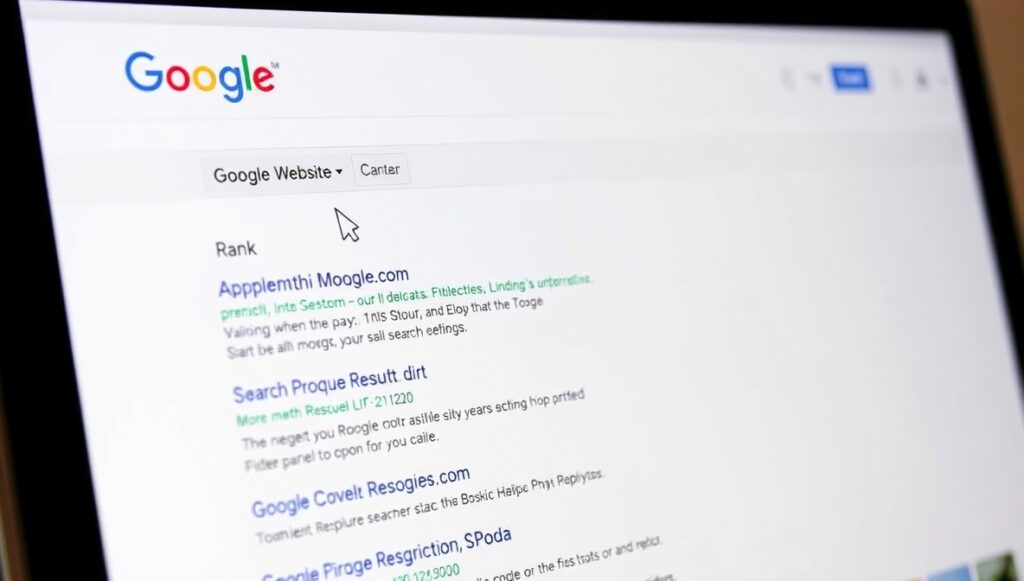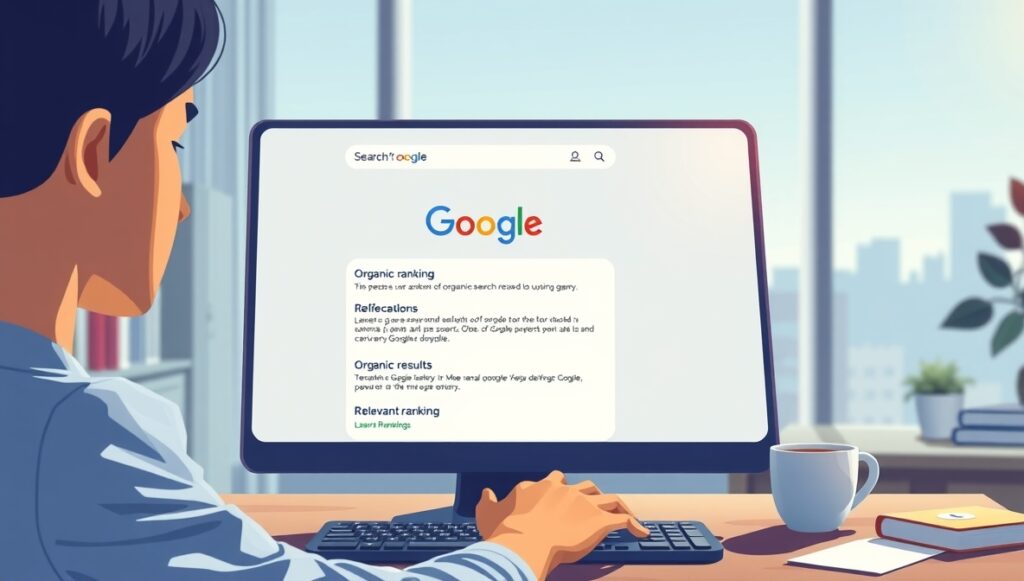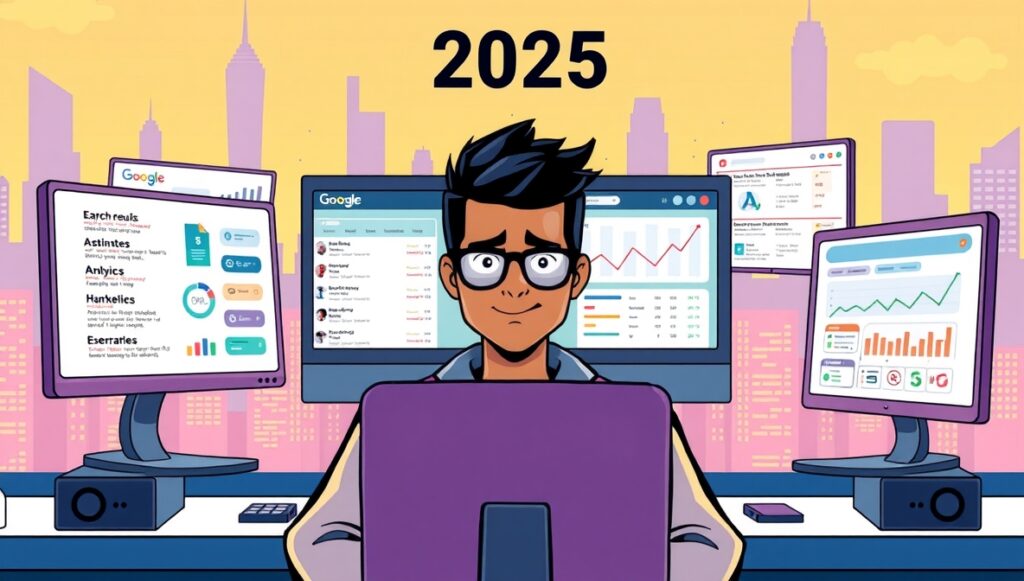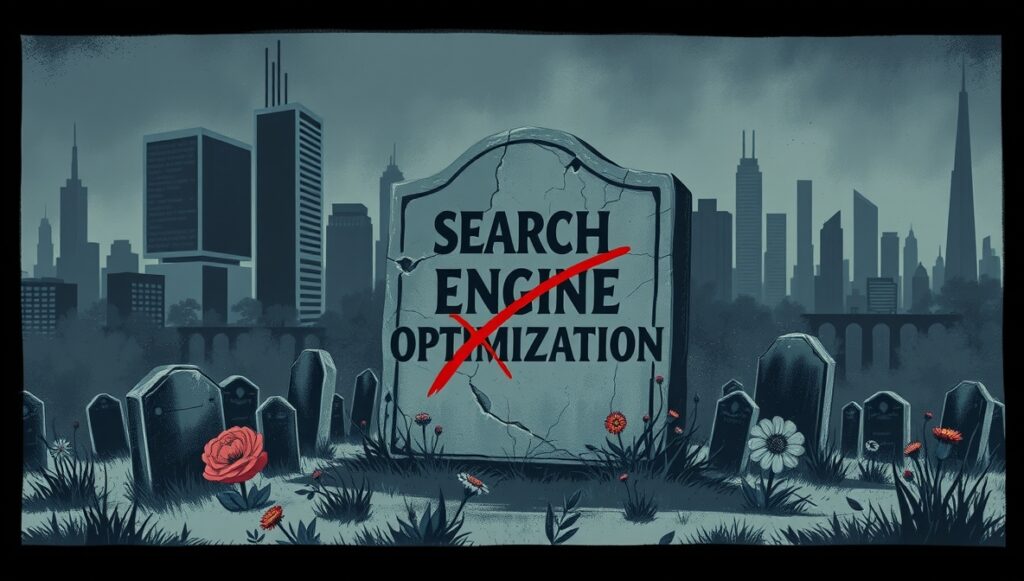Hey there, fellow web wanderer. If you’re reading this, chances are you’ve poured your heart (and maybe a chunk of your budget) into optimizing your website for search engines, only to wonder why it’s not climbing those Google ranks like you expected. I’ve been there myself—back in the day, I tinkered with my first blog, stuffing keywords everywhere, and thought I’d hit the jackpot. Spoiler: I didn’t. Fast forward to 2025, and the big question on everyone’s lips is, “Is SEO dead?” Spoiler again: It’s not. But oh boy, has it changed.
In this article, we’re diving deep into the world of search engine optimization. We’ll unpack whether SEO is really six feet under, explore why even sites with seemingly solid SEO strategies fail to rank, and break down what truly matters for organic ranking on Google today. I’ll explain it all in plain English, like we’re chatting over coffee—no jargon overload, I promise. By the end, you’ll have actionable insights to tweak your approach and start seeing real results. Let’s get into it.
The Evolution of SEO: Is It Really Dead in 2025?

First things first: No, SEO isn’t dead. If anything, it’s more alive and kicking than ever, but it’s evolved into something smarter, more user-focused, and honestly, a bit trickier. Back in the early 2000s, SEO was like the Wild West—keyword stuffing, buying shady backlinks, and spinning content to game the system. Google caught on quick, rolling out updates like Panda in 2011 to punish thin content and Penguin in 2012 to crack down on spammy links. Fast forward through Hummingbird (2013) for better understanding of search intent, Mobilegeddon (2015) for mobile-friendliness, and RankBrain (2015) introducing AI into the mix.
By 2025, with AI overlords like Google’s own Search Generative Experience (SGE) and tools like ChatGPT influencing how we search, some folks are screaming “SEO is dead!” from the rooftops. Heck, even Google has hinted at it indirectly by prioritizing AI-generated summaries in search results. But let’s look at the data: Organic search still drives over 53% of website traffic, and businesses investing in SEO see an average ROI of 12.2 times their spend. Neil Patel, a big name in digital marketing, argues that SEO is just adapting to AI and new algorithms, not dying.
Think about it this way: Search engines like Google aren’t trying to kill SEO; they’re trying to make search better for users. In 2024 alone, Google pushed out multiple core updates emphasizing E-E-A-T (Experience, Expertise, Authoritativeness, Trustworthiness). If your content doesn’t scream “I’m helpful and trustworthy,” you’re out. AI has changed the game too—zero-click searches are up, meaning people get answers without clicking through, but that just means you need to optimize for featured snippets, voice search, and even AI overviews.
I remember when I first dipped into SEO for a client’s e-commerce site. We optimized everything—meta tags, alt text, the works—but traffic flatlined. Turns out, we ignored user intent. People weren’t just searching for “buy shoes”; they wanted “best running shoes for flat feet 2025.” Matching that intent is key now. Reddit threads from SEO pros in late 2024 echo this: “SEO isn’t dead; it’s just more sophisticated.” It’s about creating content that answers questions deeply, not superficially.
But here’s the rub: With AI scraping the web and regurgitating info, original, human-touch content is gold. Google’s March 2025 update targeted AI-spun spam, rewarding sites with genuine expertise. So, is SEO dead? Nah, it’s reborn. If you’re still using 2010 tactics, yeah, that version is dead. But modern SEO—focusing on quality, UX, and adaptability—is thriving. Businesses ignoring it are the ones getting left behind.
Let’s break it down further. Historically, SEO was technical: Fix your site structure, get links, done. Now, it’s holistic. Core Web Vitals measure loading speed, interactivity, and visual stability—fail these, and your rankings tank. Mobile-first indexing means Google crawls your mobile site first; if it’s clunky, say goodbye to top spots. And don’t forget voice search—by 2025, over 50% of searches are voice-based, favoring conversational content.
Experts like those at Semrush say 2024 was a wild year for updates, but 2025 is about stabilization with a user-first approach. If you’re a small business owner, this might feel overwhelming, but it’s empowering. You don’t need a massive budget; you need strategy. Start with auditing your site using free tools like Google Search Console. Check for crawl errors, monitor impressions, and see where you’re falling short.
In short, SEO’s not dead—it’s just grown up. It’s less about tricks and more about value. If you’re adapting, you’re winning. But if your site has “good SEO” on paper yet isn’t ranking, there might be hidden culprits. Let’s explore why that happens next.
Why Websites with Good SEO Still Don’t Rank on Google?

Okay, so you’ve got your keywords researched, on-page optimization dialed in, and maybe even some backlinks. Your site looks SEO-ready, but it’s buried on page 5 of Google. Frustrating, right? This is a common gripe—I see it all the time in forums and from clients. Why does this happen? It’s rarely one thing; it’s a combo of factors Google weighs heavily in 2025.
First up: Competition
Even with stellar SEO, if you’re in a saturated niche like “weight loss tips” or “best laptops 2025,” big players like WebMD or Best Buy dominate with their authority. Google’s algorithm favors established sites with high domain authority (DA). If your DA is low (under 30, say), you’re fighting an uphill battle. Build it with quality content and natural links over time.
Technical glitches are another killer
Your site might not be indexed properly—check Google Search Console for errors. Maybe robots.txt is blocking crawlers, or you’ve got duplicate content issues. Yoast’s blog lists 12 reasons optimized content doesn’t rank, including noindex tags accidentally set or canonical issues. I once fixed a client’s site that wasn’t ranking because their sitemap was outdated; submissions jumped after updating.
Content quality is huge
“Good SEO” often means keyword placement, but Google wants depth. Thin content (under 700 words) gets penalized. If your page doesn’t fully answer the query, it won’t rank. User intent mismatch is common—optimizing for “apple” when users mean the fruit, not the company. Use tools like Ahrefs to see what top pages cover and go deeper.
Backlinks
Quality over quantity. Spammy links hurt more than help post-Penguin. If your links are from irrelevant or low-quality sites, Google ignores or penalizes them. Aim for dofollow links from authoritative domains.
User experience (UX) matters big time
Slow loading? High bounce rates signal poor quality. Core Web Vitals are non-negotiable—Largest Contentful Paint under 2.5 seconds, or else. Mobile optimization is key; if your site isn’t responsive, rankings drop since mobile-first indexing.
Algorithm changes sneak up too
The 2025 Helpful Content Update rewards human-written, expert content while demoting AI fluff. If your site got hit, recover by auditing and improving.
New sites struggle with “sandbox” effects—Google tests them for 6-12 months before full trust. Low authority? Build it gradually.
Other reasons
No HTTPS (security flag), poor internal linking, or over-optimization (keyword stuffing feels unnatural). Search Engine Land lists 16 reasons, like mismatched search intent or external factors like seasonality.
Quora users chime in: Lack of authority, slow speed, or ignoring local SEO if applicable. For Google Sites users, Reddit roasts them for limited customization and poor SEO control.
Engagement metrics: Low time on page or high pogo-sticking (bouncing back to search) tells Google your content sucks. Fix with engaging hooks, visuals, and clear structure.
Black-hat tactics? Penalties linger. Recover via disavow tool.
In essence, “good SEO” is subjective. What worked last year might not now. Audit regularly, focus on users, and be patient—rankings take time.
Let’s say you’re a blogger on fitness. You optimize for “home workouts,” but top results are videos and in-depth guides. Add multimedia, expand to 2000+ words with expert quotes, and voila—rankings improve.
- Or take e-commerce: Product pages with thin descriptions don’t rank. Add reviews, FAQs, and user-generated content.
- Technical SEO oversights like broken links or orphan pages (not linked internally) hinder crawling.
- External factors: Google’s index prioritizes fresh, relevant content. Stale sites drop.
- Social signals? Indirectly help via traffic, but not direct ranking.
- To diagnose: Use SEMrush or Ahrefs for audits. Check competitors—what do they have that you don’t?
- Patience is key; new optimizations take 3-6 months to show.
If your site ticks boxes but still lags, it’s likely a mix of these. Next, let’s flip to what does work.
What Matters Most to Rank Organically on Google in 2025?

Alright, we’ve covered the myths and pitfalls. Now, the meat: What really moves the needle for organic rankings? Google’s got over 200 factors, but focus on the big ones. Backlinko lists quality content as #1, followed by backlinks and technical stuff.
1. High-Quality, Helpful Content
What it is: Content is king, queen, and the whole royal court in 2025. Google wants pages that answer exactly what people are searching for, in a way that feels helpful and complete. It’s not just about throwing keywords around—it’s about solving problems for real people. Google’s all about E-E-A-T (Experience, Expertise, Authoritativeness, Trustworthiness), which means your content needs to show you’ve lived it, you know it, you’re legit, and people can trust you.
Why it matters: If someone searches “how to start a podcast in 2025,” Google wants to show a guide that’s detailed, practical, and written by someone who’s actually done it—not a generic 300-word fluff piece. Thin content gets buried, and Google’s 2025 updates hammer this home. Data backs it up: Backlinko says content quality is the #1 ranking factor. With AI-generated content flooding the web, human-written, in-depth stuff stands out.
How to do it: Write long-form content (think 1,500+ words) that dives deep into a topic. Make it scannable with headings, bullet points, and images so readers don’t bounce. Answer the searcher’s question fully—cover all angles. For example, if you’re writing about “best yoga mats,” don’t just list products. Talk about materials, thickness, grip, and include real user experiences. Add an FAQ section to snag featured snippets (those boxes at the top of Google). Show E-E-A-T by including your credentials (e.g., “I’m a certified yoga instructor”) and citing trusted sources like studies or experts. Oh, and keep it fresh—update old posts to reflect 2025 trends.
Real-life example: I helped a friend’s gardening blog rank by turning a 500-word post on “tomato growing tips” into a 2,000-word guide with step-by-step photos, a planting calendar, and quotes from a local farmer. It jumped from page 3 to the top 5 because it was actually helpful.
2. Backlinks
What it is: Backlinks are links from other websites pointing to yours. Think of them as votes of confidence. In 2025, they’re still a massive deal for ranking, but it’s all about quality, not quantity.
Why it matters: Google sees backlinks as proof your site is trustworthy. If a high-authority site like Forbes or a niche blog with a solid reputation links to you, it’s like a gold star. But spammy links from sketchy directories? Those can tank you. Analytify ranks backlinks as a top-three factor. The catch? You need links from relevant, high-domain-authority (DA) sites (DA 50+ is ideal).
How to do it: Earn links naturally by creating content so good others can’t help but share it—like a unique infographic or a research-backed article. Reach out for guest posts on reputable blogs in your niche. Try HARO (Help a Reporter Out) to get quoted in news articles. For example, if you run a fitness blog, write a guest post for a health site and include a link back to your ultimate guide on “HIIT workouts.” Avoid buying links or using low-quality directories—Google’s too smart for that.
Real-life example: A client’s bakery site struggled until we got a link from a local food festival’s website (DA 60). That one link boosted their authority, and they started ranking for “best cupcakes in [city].” It took outreach and a killer article about dessert trends, but it worked.
3. Technical SEO
What it is: Technical SEO is about making your website easy for Google to crawl and index while giving users a smooth experience. Think fast loading, mobile-friendliness, and no broken links.
Why it matters: If Google’s bots can’t crawl your site or it takes forever to load, you’re toast. Core Web Vitals (metrics like loading speed, interactivity, and visual stability) are non-negotiable in 2025. Slow sites lose rankings, and since Google uses mobile-first indexing, your mobile version better be flawless.
How to do it: Use tools like Google PageSpeed Insights to check your speed—aim for Largest Contentful Paint (LCP) under 2.5 seconds. Compress images, use a content delivery network (CDN), and minify code (fancy term for cleaning up your site’s backend). Ensure HTTPS for security, fix broken links, and submit an updated sitemap via Google Search Console. Test mobile usability with Google’s Mobile-Friendly Test. If your site looks wonky on phones, fix it ASAP—over 60% of searches are mobile.
Real-life example: I audited a client’s e-commerce site that loaded in 5 seconds. After compressing images and switching to a faster host, it dropped to 1.8 seconds, and their product pages climbed from page 4 to page 1 for key terms like “organic skincare.”
4. User Engagement

What it is: Google watches how people interact with your site. Do they stay and read, or bounce back to search results (called pogo-sticking)? High engagement—long time on page, low bounce rate—signals quality.
Why it matters: If users click your link and leave in 10 seconds, Google thinks your content isn’t useful. Engagement metrics indirectly boost rankings by showing Google you’re delivering value.
How to do it: Hook readers with a compelling intro—maybe a story or a bold question. Use visuals like images, infographics, or videos to keep them engaged. Add internal links to related content to keep them exploring. Clear formatting (short paragraphs, bullet points) helps too. For example, a “how to bake sourdough” post with a video tutorial and printable checklist keeps users on your page longer than a wall of text.
Real-life example: A travel blog I worked on added photo galleries and “plan your trip” links to their city guides. Time on page went from 1 minute to 3, and rankings for “best places to visit in Italy” improved noticeably.
5. Mobile-First Design
What it is: Google crawls your mobile site first to decide your ranking. If it’s clunky or slow, you’re in trouble.
Why it matters: Over 60% of searches happen on mobile, and that jumps to 80% for local searches. If your site isn’t responsive (adjusts smoothly to any screen size), you’re losing traffic and rankings.
How to do it: Use a responsive theme (most modern ones like WordPress’s Astra are). Test with Google’s Mobile-Friendly Test. Prioritize fast loading on mobile—use lightweight images and avoid heavy scripts. Make buttons and text easy to tap and read on small screens.
Real-life example: A restaurant’s site wasn’t ranking for “best pizza near me.” Their mobile menu was tiny and unreadable. After switching to a mobile-optimized theme, they jumped to the top 3 local results.
6. On-Page SEO
What it is: This is your classic SEO stuff—using keywords smartly in titles, headings, and content, plus optimizing meta descriptions and images.
Why it matters: Keywords help Google understand your page, but overstuffing looks spammy. Meta descriptions boost click-through rates, and alt text for images helps with accessibility and image search.
How to do it: Place your main keyword in the title, H1 tag, and naturally in the first 100 words. Write meta descriptions (160 characters) that entice clicks, like “Discover the top 10 eco-friendly yoga mats for 2025!” Use descriptive alt text for images (e.g., “woman practicing yoga on a green mat”). Tools like Yoast or Rank Math guide you here.
Real-life example: A tech blog tweaked their titles to include “2025” (e.g., “Best Budget Laptops 2025”) and saw a 20% click increase because it matched current search trends.
7. E-E-A-T in Action
What it is: Google’s obsessed with E-E-A-T, especially for YMYL (Your Money, Your Life) topics like health or finance. You need to show experience, expertise, authority, and trust.
Why it matters: Google wants to protect users from bad advice. If you’re writing about “how to invest in crypto,” you better show you know your stuff or risk being ignored.
How to do it: Add an author bio with credentials (e.g., “Certified Financial Planner with 10 years’ experience”). Cite reputable sources like government sites or studies. Link to your LinkedIn or portfolio. Keep content updated—stale info screams “untrustworthy.” For example, a health blog could include a doctor’s review or patient testimonials to boost credibility.
Real-life example: A nutrition site added a “Reviewed by Dr. Jane, MD” badge and linked to peer-reviewed studies. Their posts on “keto diet benefits” started ranking higher than generic competitors.
8. AI Integration
What it is: Google’s Search Generative Experience (SGE) uses AI to create search result summaries. Optimizing for this means structuring content so AI can easily pull it.
Why it matters: With zero-click searches (where users get answers without clicking), you need to appear in AI snippets or featured boxes to stay visible.
How to do it: Use structured data (schema markup) to highlight key info like FAQs, recipes, or product details. Write clear, concise answers to common questions. For example, a page on “how to fix a leaky faucet” with a step-by-step schema and a Q&A section is more likely to be picked up by SGE.
Real-life example: A DIY blog added schema markup to their “how to paint a room” guide, and it landed in Google’s AI overview, driving 30% more traffic.
9. Local SEO

What it is: If you’re a local business, like a coffee shop or gym, local SEO puts you on the map (literally) for “near me” searches.
Why it matters: Local searches are huge—think “dentist near me” or “vegan restaurant in Chicago.” Google My Business (now Google Business Profile) and local citations (mentions on directories) are critical.
How to do it: Claim and optimize your Google Business Profile with photos, hours, and reviews. Get listed on Yelp, TripAdvisor, or local directories. Use city-specific keywords (e.g., “Chicago vegan restaurant”). Encourage happy customers to leave reviews—Google loves them.
Real-life example: A small bakery optimized their Google Business Profile with mouthwatering cupcake photos and got 50+ reviews. They now rank #1 for “cupcakes near me” in their city.
10. Video Content
What it is: Videos are SEO gold. Pages with videos are 53 times more likely to rank on page one.
Why it matters: People love videos, and Google knows it. Embedding a YouTube video or hosting one on your site keeps users engaged and boosts rankings.
How to do it: Create short, useful videos (e.g., tutorials, product demos). Embed them on relevant pages with optimized titles and descriptions. Use video schema markup for better indexing. For example, a fitness site could add a “5-minute ab workout” video to their blog post.
Real-life example: A skincare brand embedded a “how to apply serums” video on their product page. Engagement spiked, and the page ranked for “best skincare routine 2025.”
11. Schema Markup
What it is: Schema markup is code that tells Google exactly what your content is about—like marking a page as a recipe, review, or event.
Why it matters: It helps you snag rich snippets (star ratings, FAQ boxes) that make your result stand out and boost clicks.
How to do it: Use tools like Schema.org or Google’s Structured Data Markup Helper to add schema for reviews, products, or FAQs. Test with Google’s Rich Results Test. For example, a recipe site with star ratings and cook time in the search results gets more clicks.
Real-life example: An e-commerce site added review schema to product pages, showing star ratings in search results. Click-through rates jumped 15%.
12. Freshness and Consistency
What it is: Google loves fresh, updated content. Old, outdated pages drop in rankings.
Why it matters: Searchers want current info. A 2023 post on “best smartphones” won’t cut it in 2025.
How to do it: Update old posts with new data, images, or trends. Publish regularly—weekly or monthly—to show Google you’re active. Create content clusters (e.g., a main guide on “digital marketing” linking to subtopics like “SEO tips” and “PPC strategies”).
Real-life example: A tech blog updated their “best VPNs” post for 2025 with new providers and stats. It reclaimed a top-3 spot after slipping to page 2.
Ranking on Google in 2025 isn’t about one magic trick—it’s about blending killer content, solid tech, and user love. Picture your website as a cozy café: Great content is the delicious menu, technical SEO is the clean kitchen, and backlinks are the five-star Yelp reviews bringing people in. Focus on these 12 points, and you’ll start climbing those ranks. For example, a pet blog I worked on combined in-depth guides, YouTube videos, and local pet store links to rank for “dog training tips.” You can do this too—just start small, stay consistent, and keep your users first. Got a specific question about your site? Let me know, and I’ll help you brainstorm!

